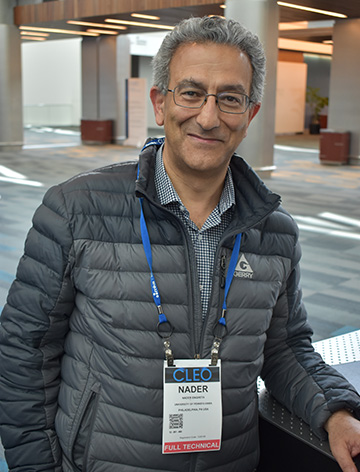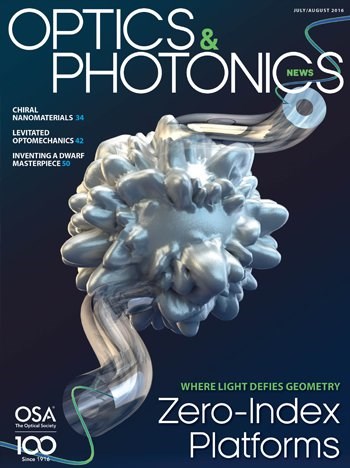
Nader Engheta at CLEO 2107.
At CLEO 2018 in San Jose, Calif., USA, OPN had the opportunity to talk with Nader Engheta, an OSA Fellow and the H. Nedwill Ramsey Professor at the University of Pennsylvania, USA. Engheta gave one of the Tuesday morning plenary talks at the conference, on the promise of “metaphotonics”—the whole constellation of new possibilities that advances in nanotechnology and metamaterials are making possible.
Early in your plenary talk, you alluded to Richard Feynman’s famous talk in 1959, “There’s Plenty of Room at the Bottom,” in which he envisioned some aspects of modern nanotechnology. You suggested that, similarly, there’s still plenty of room to explore the “extreme” applications of optical metamaterials. Where do you see the biggest potential wins for metaphotonics?
There’s a long list of topics that relate to the “extreme” aspects of metamaterials. To pick just a few: One aspect is to see whether metamaterials can help us informatics—in machine learning, in information processing. Can metamaterials help that? Can they be a programmable platform—can we have FPGA-type light-matter interactions? FPGAs—field-programmable gate arrays—are a very powerful platform in electronics. Can one do that in the form of metamaterials?
Another one goes back to the notion of near-zero-index photonics, which we covered in a feature in OPN two years ago. That, in itself, is another extreme, obviously. And a third example is merging metamaterials with 2-D materials, like graphene. That’s another extreme—can we have one-atom-thick circuits, or one-atom- or few-atoms-thick optical devices? These are some of the extremes that we can pick from the list.
Let’s drill down into some of those. You talked about circuit elements from metamaterials—optical analogs of resistors, inductors, capacitors. Why should we look at these applications now?
It’s a very good question. Since I was a grad student, I’ve been puzzled by this—in circuit theory, we have lumped elements; why not have lumped elements in optics? The answer has been clear: the relative size, the optical wavelength. But the fact that we can have lumped circuit elements in electronic systems—it’s just like the alphabet of a language. It has actually provided us with a very interesting way to put things together and create an infinite number of functionalities we’ve seen in our electronics. So I’ve been interested to see if we can do that kind of modularization in photonics.
The reason to look at this now is that now we can make a structure much smaller than the wavelength of light. That capability didn’t exist at the beginning of the 20th century—that’s why there were no lumped elements for optics. But because of nanotechnology, we can make structures much smaller than the wavelength of light. But that’s not enough—we also have to engineer the material response. So the combination of the material, and the fact that we can make the size small compared with the wavelength, allows us to have nanostructures we can call lumped circuit elements.
Having this type of modularity, in my opinion, lets the fields of electronics and photonics merge together—you get the same set of “alphabets.” And as a result we can have a two-way transfer of ideas between the two fields.
One intriguing line of research you mentioned in your talk was analog information processing—“letting metamaterials do the math.” You and your team have designed materials that can even, through interaction with a light field, solve complex, nonseparable integral equations.
Yes. One thing that I need to make clear, though, is that we’re exploring analog processing. This is very different from optical logic gates—what we’re talking about is entirely analog computing. Our idea is to explore how we can use waves interacting with specially designed materials, hopefully with as small a footprint as possible, such that it will do information processing. Solving integral equations is one example of that; filtering is another; hopefully machine learning and other things we’d like to do in the future will be still another example. It’s analog processing with waves.
The potential advantages of this are, first, low power; also a small footprint—hopefully in the nanoscale, or a few wavelengths.
You design these equation-solving metamaterials, as you described in your talk, through an inverse process that iterates and tunes the required feedback until the input matches the desired output. That seems like a significant amount of work to solve a specific equation—how does that become generalizable?
You design the material for a given kernel of an integral equation. When you do it once, then you can put any input into the integral equation, and you’ll get the right output. We design the material for the kernel, which corresponds to a specific physical problem, and once we’ve designed it you’re done for all inputs.
And there are other ways you might do this beyond metamaterials, that are more reconfigurable. One thing we’re looking at as an alternative is combinations of Mach-Zehnder interferometers.
You also talked about near-zero-index materials, a topic on which, as you mentioned, you co-authored a feature for OPN two years ago. These materials can enable some amazing things, like cavities whose resonance frequency is independent of geometry, and “supercoupling” of light through subwavelength channels with unusual bends. How do you see the path toward commercialization of these materials—and what’s the “killer app” that will push them into the mainstream?
That’s a very exciting topic. If I were to pick one or two killer applications, one is flexible photonics. These near-zero-index platforms allow us to have a structure where, when you bend it, it doesn’t change its resonant frequency, it doesn’t change its transmission. So that’s one. Another, which we’ve recently started studying, is the thermal aspect. Since this near-zero-index property can actually enhance the spatial coherence of the structure, you can have very interesting thermal radiation. You might be able even to have a beaming of thermal radiation, almost the same way that antenna arrays do in the microwave.
At the end of your talk, you had some inspiring words about the need to make sure that curiosity-driven research is adequately valued, and that scientists have room to ask the “why not” and “what if” questions. Is there an outstanding example, in your own career where “what if/why not” research has led to surprising and consequential impacts?
Yes! The whole notion of near-zero-index supercoupling, and the features that followed that, started with a purely curiosity-driven question. I didn’t have a specific application in mind; it was just a “what would happen” question.
Another example from my research, which has nothing to do with metamaterials and you might not be familiar with, is bioinspired polarization imaging. This was started as a purely curiosity-driven question started with a colleague in the Psychology Department at the University of Pennsylvania. We know that there are animal species in nature that can see polarization of light, and human eyes are “polarization blind.”
The question was, “what if” we can create a camera that can see the world just like a polarization-sensitive eye can see the world? And that actually started an area of research for me that led to a very interesting set of developments—patents came out of that, and a lot of other interesting developments. And it started as a curiosity-driven question.

